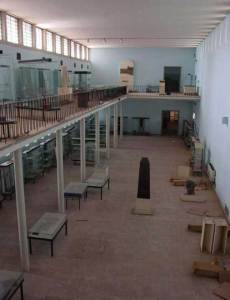From the February issue of Apollo: preview and subscribe here
With so many archaeological and cultural sites at risk in war zones around the world, is enough being done to protect them? And what can we learn from the mistakes that led to the looting in Iraq in 2003?
Between these words being written and read, cultural property, including buildings, archaeological sites, libraries, archives, and art will have been damaged or destroyed across the world as the result of armed conflict. More will have been looted and sold illegally. The illicit trade in antiquities, much of which is looted during armed conflict, is suggested to be the third largest international crime network (after guns and drugs) and has helped to fund conflicts in Afghanistan, Iraq, and Syria.
Cultural property is destroyed or damaged in four ways: through ‘traditional’ looting by the military (and others associated with the victor) of the heritage of the vanquished foe; through collateral damage (e.g. the destruction of entire historic areas in the World Wars, and recently in Syria); through military negligence (e.g. the use of Babylon and Ur in Iraq as military bases by Coalition troops, and the use of the Crac des Chevaliers in Syria by forces opposing the current regime); and through the targeting of a site for the cultural affiliations it displays (e.g. in the Balkan Wars in the 1990s, and more recently in Mali and northern Iraq).
Most of us simply accept this situation as an unfortunate but inevitable consequence of war and think little more of it. However, this has not always been the reaction. Nearly every military strategist of the last 2,000 years, from Sun Tzu to Clausewitz, has argued that looting the heritage of a vanquished enemy is a poor military and political tactic as it will create lasting hatred and a simmering cause for the reignition of conflict. And at least some of the recent destruction could be avoided if the military and politicians took the protection of cultural property during conflict more seriously.
During the American Civil War the Lieber Code became the first legal instrument to protect cultural property and a number of international meetings and conventions followed that began to formulate the legal protection of cultural property during conflict. This activity was noted in the Second World War by the Allies, who set up the Monuments, Fine Art and Archives unit (the ‘Monuments Men’) to try to safeguard and repatriate as much of the cultural heritage of Europe and the Far East as possible. Officers commanding units in the Italian and Normandy invasions, for example, were specifically ordered not to allow cultural property to be destroyed through collateral damage unless there was no other military option.
At the end of the Second World War the international community reacted to the massive destruction of cultural property by producing the 1954 Hague Convention for the Protection of Cultural Property in the Event of Armed Conflict and an associated Protocol. The Convention adopted a blue shield as an emblem to identify cultural property to be protected. The idea of protecting cultural sites and artefacts during armed conflict slipped from the agenda during the Cold War; the issue only became international news again after the deliberate targeting of cultural sites in the former Yugoslavia in the 1990s. A second Protocol to the Convention was produced in 1999. This made it possible for the deliberate destruction of, or damage to, cultural property to become a criminal offence.
A looter points to where he found an object on an archaeological site in southern Iraq in 2003. Photo: © JOanne Farchakh Bajjaly

However, it was only after the looting of the National Museum of Iraq in 2003 that the issue captured the world’s attention again. The catastrophic destruction of cultural heritage in Iraq that followed the US/UK led Coalition invasion was due, in no small part, to the failure of the Coalition to plan for its protection. In 2003, mainly because of concerns regarding protection during the Cold War, neither the US nor UK had ratified the Convention or its protocols. The US ratified the Convention, but not Protocols, in 2009. Despite numerous pledges to do so the UK has still not ratified, leaving it as arguably the most significant military power, and the only one with extensive military involvements abroad, not to have ratified the Convention.
The 1999 Protocol identifies the Blue Shield organisation as an advisory body to the Intergovernmental Committee for the 1954 Convention. The Blue Shield is referred to frequently as the ‘cultural equivalent’ of the Red Cross. There are, however, three key differences: First, the Red Cross has had some 150 years to establish a worldwide reputation; the Blue Shield has only been in existence for 18 years and is virtually unknown outside those involved in its community and some armed forces. Second, the Red Cross has a multimillion pound budget; save for a time-limited, short-term, grant for an office from the municipality of The Hague, and limited travel funding from Newcastle University, the Blue Shield has no income. Third, the Red Cross has a paid professional staff of some 12,000 people in 80 countries; the Blue Shield has no paid staff at all.
An American tank outside National Museum of Iraq in 2003 – a few days after the unprotected museum had already been looted. Photo: © Joanne Farchakh Bajjaly

Despite this, the Blue Shield has made significant progress over the last decade. It now has 17 national committees and nine more under construction. After countless meetings with military and other emergency organisations it is slowly becoming accepted as a relevant and reliable organisation nationally and internationally. The military has begun to accept the value of protecting cultural property not as a last-minute, nuisance ‘bolt-on’, but as a ‘force-multiplier’ – something that has the potential to make its work, if not easier, then not more difficult. Some armed forces are now willing to discuss what is referred to as the ‘four tier’ approach to Blue Shield/military co-operation (long-term; immediate pre-deployment; during conflict; and post-conflict). Last year NATO asked Blue Shield to help draft a publication entitled Cultural Property Protection Makes Sense, and Blue Shield members have led training programmes for the military and emergency organisations in, for example, the US, a number of European countries, Lebanon, and Mali. Blue Shield members have also undertaken during- and post-conflict assessment missions in Egypt, Libya, and Mali, monitoring and collecting evidence of damage. Together with national experts, the Blue Shield has also produced lists of cultural property to be protected if possible during recent conflicts in Iraq, Libya, Mali, and Syria. These have been passed on to national and international military forces to be put on so-called ‘no-strike’ lists including non-military buildings such as hospitals, religious sites, and schools.
One of six vehicles destroyed by a NATO strike outside the relatively untouched Roman fort at Ras Almargeb, Libya in 2011. Photo: © Joseph Kila

While the value of such lists has been questioned, one example from Libya indicates their importance. Forces loyal to the Gaddafi regime, presumably hoping that NATO would take damage to cultural property into consideration, had parked six vehicles of a mobile radar unit next to the Roman fort at Ras Almargeb. The site was indeed on the list submitted to NATO by the Blue Shield. As a result, NATO forces were able to plan the precise destruction of the military targets with very minimal shrapnel damage to the fort. The success of this operation, and the positive international press coverage that it received, led NATO to commission an internal report on Cultural Property Protection in the Operations Planning Process. This recommended that NATO should develop its own protection doctrine. As yet, the report’s recommendations have not been implemented but Blue Shield is working with NATO to develop the concept.
One of the galleries of the National Museum of Iraq after the looting. Staff had emptied most of the cabinets in time; the looting was from store rooms. Photo: © Joanne Farchakh Bajjaly

Why is the protection of cultural property important? There are several interrelated reasons. First, the physical evidence of the past is crucial to the study of the history of human societies. While this may seem a minor issue in wartime, without the tangible evidence of the past a credible history of the human race cannot be created. Secondly, we study the past to understand the present, to create the future: cultural property, the buildings and objects of the past, provide the context, vehicle, and stage for this understanding. Without it, not only would academics be unable to investigate the past but, more pragmatically, communities will struggle to build the future – especially as they emerge from conflict. This leads to the third reason: evidence emerging from Iraq suggests that destruction of cultural property is directly linked to increased loss of life, as people respond to the loss of their heritage with more violence. Fourthly, a community without memory can easily become a dysfunctional community, without an identity, unable to cope without support – the memory of societies are locked within their cultural property. Linked to this is the fifth reason: many pieces of recent research have shown that communities living in landscapes that include historic features have a greater level of ‘well-being’. And finally, cultural property can lead to post-conflict economic regeneration through tourism.
Despite some accusations to the contrary, those working for the Blue Shield fully acknowledge and accept, without any reservation, that the protection of cultural property must come a distant second to the protection of civilian populations. However, the protection of people, and the protection of their identity, go hand-in-hand. There is still an enormous amount to do before the protection of cultural property will become an integral part of military and political agendas, but the journey has begun.
Peter Stone is Head of the School of Arts and Culture at Newcastle University and Secretary General of the Association of National Committees of the Blue Shield.
Click here to buy the latest issue of Apollo
The Apollo Inquiry
Right or wrong? | Is it time to rethink copyright legislation?
Attention Seekers | Do touchscreens, apps and the like enrich visitor experience?
The Asian Biennial Boom | How have unconventional spaces shaped artists’ practices in the region?
Art law and attribution | Do art historians and other art authenticators need greater legal protection?
Hard times for the UK’s regional museums? | How have recent funding cuts affected museums?

